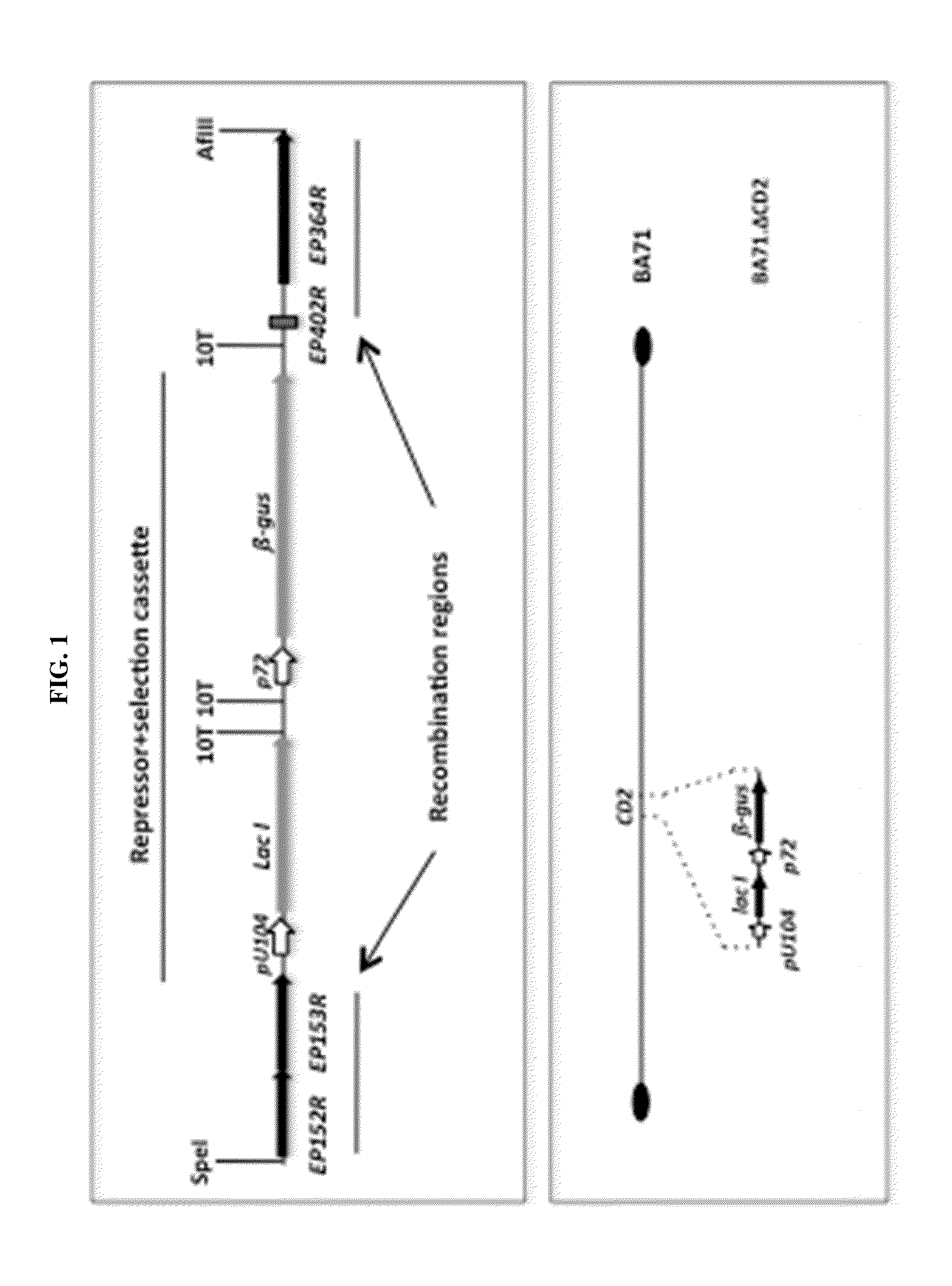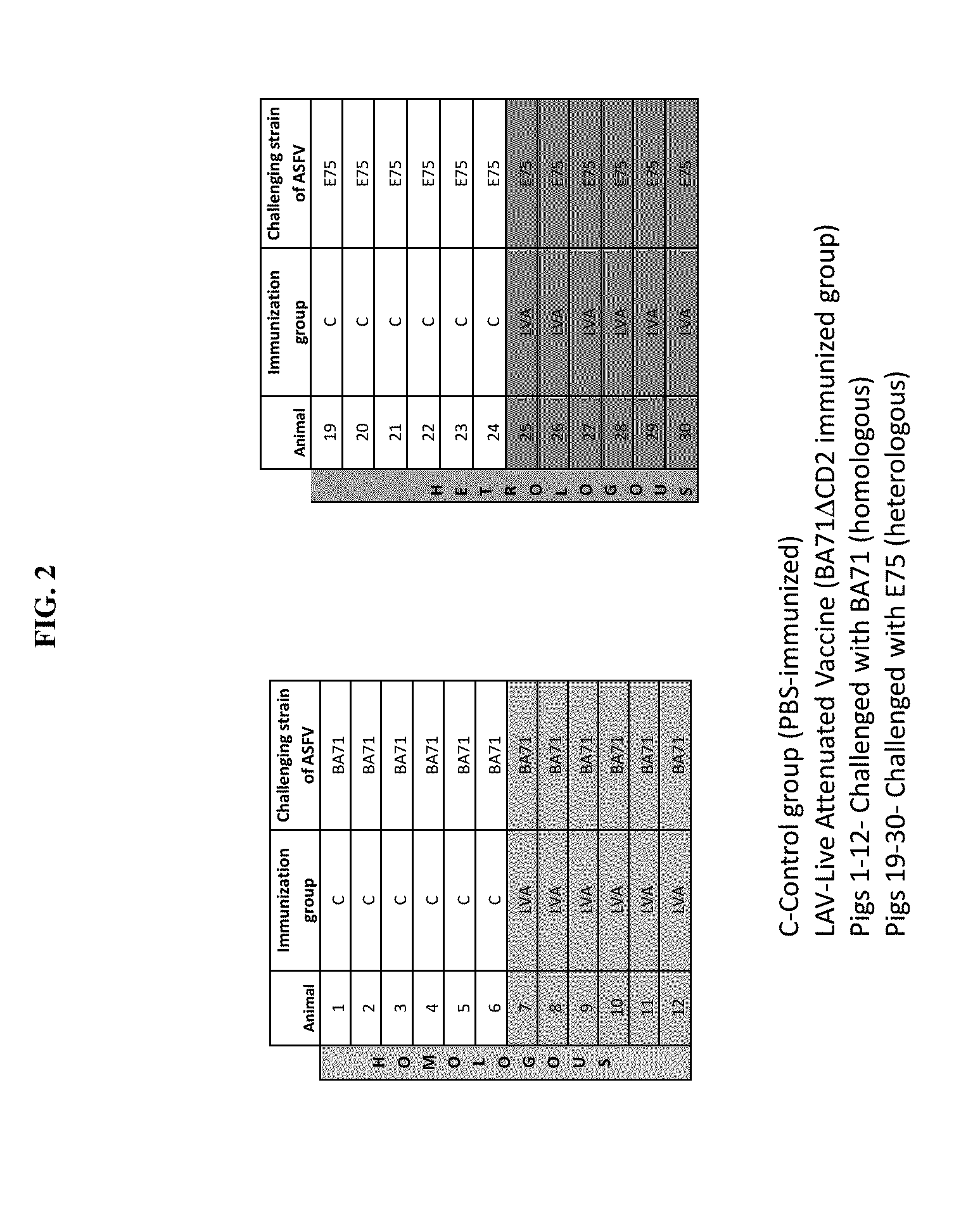CD2 deficient african swine fever virus as live attenuated or subsequently inactivated vaccine against african swine fever in mammals
a technology of african swine fever virus and live attenuation or inactivation, applied in the field of medicine, can solve the problems of affecting the safety of patients, and reducing the number of vaccines available in the market, so as to reduce the risk of infection, reduce side effects, and minimize the potential damage of uninfected cells
- Summary
- Abstract
- Description
- Claims
- Application Information
AI Technical Summary
Benefits of technology
Problems solved by technology
Method used
Image
Examples
example 1
[0106]For the construction of the recombinant by homologous recombination, the recombination plasmid shown in the upper panel of FIG. 1 was used. This plasmid contains the repressor+selection cassette consisting of the Lac I repressor gene under the control of the ASFV early / late promoter pUl 04 and the marker β-glucuronidase gene under the control of the late p72 promoter. The plasmid also contains the recombination regions that consist of genes EP152R and EP153R genes at the left, and, at the right, the EP364R gene and a 36 base pair region at the end of gene EP402R coding for the ASFV CD2.
[0107]The BA71.ΔCD2 (FIG. 1, lower panel) was obtained by homologous recombination of the recombination plasmid with BA71 in COS-7 cells. The recombinant virus was purified by successive plaque formation in COS-7 cells, selecting blue plaques stained with X-Gluc, the substrate of β-glucuronidase, until only blue plaques are detected. The ASFV was amplified by growth in COS-7 cells.
[0108]To produ...
example 2
[0109]Once obtained, the BA71.ΔCD2, purified or not, was used for vaccine purposes attending the following experimental design:[0110]Twenty-four (24) Landrace x Pietrain commercial pigs (four week old males) were hosted in two boxes (12 pigs per box): BOX A and BOX B, within BSL3-facilities.[0111]Each box was divided into 2 immunization groups (6 pigs in each group):[0112]Control Group (C): Intramuscularly immunized with PBS[0113]Live Attenuated Virus (LAV): Intramuscularly immunized with 103 pfu of the ASFV CD2-deletion mutant BA71ΔCD2[0114]All pigs in box A were challenged intramuscularly with a lethal dose of 103 Haemadsorbing units (HAU50) of the virulent BA71 ASFV isolate (20LD50 homologous challenge)[0115]All pigs in box B were challenged intramuscularly with a lethal dose of 104 HAU50 of the virulent E75 ASFV isolate (20LD50 heterologous challenge)
[0116]FIG. 2 summarizes the information for each pig including identification number, immunization group, and the viruses used for...
example 3
[0136]In order to demonstrate a dose-dependent effect of BA71ΔCD2-induced protection, pigs were immunized with either 3.3×104 pfu or 106 pfu of BA71ΔCD2 (in Example 2, pigs received 103 pfu of the ASFV CD2-deletion mutant BA71ΔCD2).
[0137]As expected, all control pigs, either challenged either with 104 HAU50 (GEC) of E75 (5 out of 5) or with 103 HAU50 (GEC) of BA71 (5 out of 5) died before day 9 post-challenge (pc). In clear contrast, 100% of the pigs vaccinated with BA71ΔCD2 (24 out of 24) survived the lethal challenge, independently of the vaccine dose used or the challenged performed (homologous BA71 or heterologous E75; FIG. 10). This is the first demonstration of total cross-protection for these two ASFV isolates. Protection correlated with the induction of specific antibody and T-cell responses, correlating with the protection afforded.
[0138]Immunization with either 3.3×104 pfu or 106 pfu of BA71ΔCD2 was safe for the animals with only one out of 12 pigs showing low viremia by d...
PUM
| Property | Measurement | Unit |
|---|---|---|
| volume | aaaaa | aaaaa |
| volume | aaaaa | aaaaa |
| volume | aaaaa | aaaaa |
Abstract
Description
Claims
Application Information
 Login to View More
Login to View More - R&D
- Intellectual Property
- Life Sciences
- Materials
- Tech Scout
- Unparalleled Data Quality
- Higher Quality Content
- 60% Fewer Hallucinations
Browse by: Latest US Patents, China's latest patents, Technical Efficacy Thesaurus, Application Domain, Technology Topic, Popular Technical Reports.
© 2025 PatSnap. All rights reserved.Legal|Privacy policy|Modern Slavery Act Transparency Statement|Sitemap|About US| Contact US: help@patsnap.com



